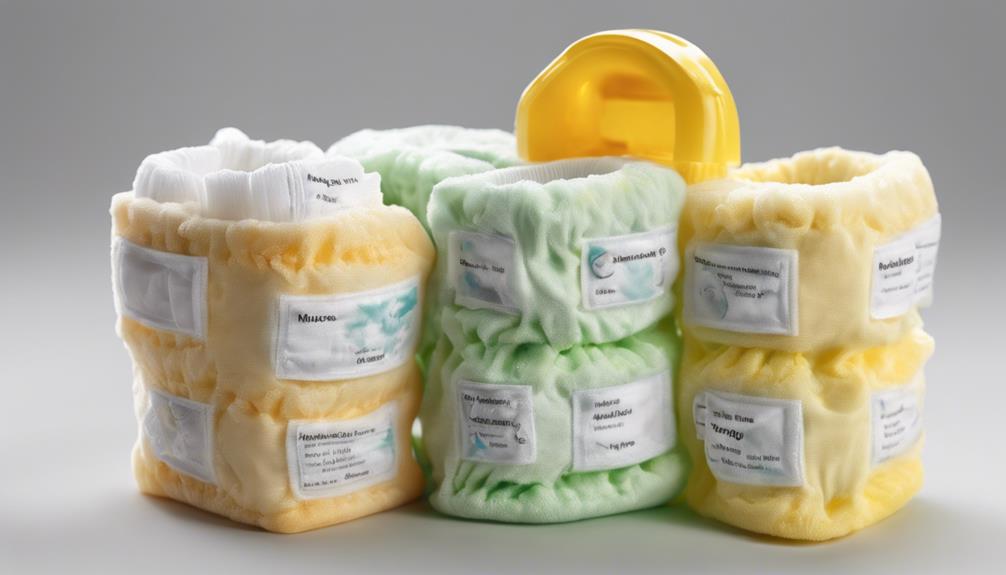When it comes to helping your newborn poop, they say 'patience is a virtue.' Establishing a routine and making gradual dietary changes are key.
But what about those days when nothing seems to work, and your little one is still uncomfortable? There are effective strategies and gentle methods that can assist in getting things moving smoothly.
Stay tuned to uncover these steps and make sure your baby's well-being stays a top priority.
Key Takeaways
- Monitor bowel movements for frequency and consistency.
- Adjust feeding based on baby's needs (breastfed vs. formula-fed).
- Use gentle techniques like belly massage or warm baths.
- Seek medical advice if constipation persists or if stool color is abnormal.
Signs of Newborn Constipation
If your newborn is experiencing infrequent bowel movements of less than one per day, they may be showing signs of constipation. As caregivers, it's vital to be attentive to the frequency and consistency of your baby's stools. Signs of constipation in babies include straining during bowel movements, passing hard stools, and displaying discomfort. If your baby is going more than 2-3 days without a bowel movement, it could indicate constipation. Keep an eye out for small, hard, and dry stools in your baby's diaper as this could be a sign of constipation.
Additionally, observing your newborn for signs of discomfort, irritability, and abdominal bloating can also help identify constipation. If you notice these signs, try giving your baby a warm bath or gently massaging their belly to help stimulate bowel movements. It's important to address constipation early to guarantee your baby's comfort and overall well-being.
Understanding Baby Bowel Movements
Let's explore the fascinating world of baby bowel movements, shedding light on the intricacies of how their stools evolve and what these changes signify for their health and well-being. In the early days, newborns pass meconium, a dark greenish tar-like stool. Breastfed babies typically have yellow, seedy, mustard-like stools, while formula-fed babies may have firmer, well-formed stools. As babies grow and begin to shift to solid foods, the frequency and characteristics of their stools can change.
Monitoring how your baby's stool looks is important in understanding their digestive system. Changes in stool color, consistency, and frequency can indicate potential issues like constipation. Signs of constipation include hard, pellet-like stools or difficulty passing stools. If your baby is constipated, gentle methods like giving them a warm bath or gently massaging their belly can help. Remember, each baby is unique, and ensuring to keep track of what's normal for your little one to guarantee their health and comfort.
Feeding Adjustments for Newborns
Exploring the best feeding adjustments for newborns can greatly impact their digestive health and overall well-being. When it comes to feeding adjustments for newborns, whether breast-fed or formula-fed, there are several strategies to contemplate:
- Breast-fed Babies: For breast-fed newborns, adjusting the mother's diet can play a significant role in their digestive health. Avoiding dairy or gassy foods may help relieve constipation and regulate bowel movements.
- Formula-fed Babies: Formula-fed newborns may benefit from trying different formulas or adjusting the formula-to-water ratio to ease constipation. Under the guidance of a healthcare provider, offering small amounts of water can also aid in bowel movements.
- Introducing to Solids: Introducing pureed 'p-foods' such as prunes, peaches, or pears can be beneficial for newborns starting to solid foods. These foods can help regulate bowel movements and promote healthy digestion during this important stage.
Making these feeding adjustments can help make sure that your newborn's digestive system stays healthy and functioning properly.
Gentle Techniques to Stimulate Bowel Movements
After making feeding adjustments to promote your newborn's digestive health, it's important to think about gentle techniques that can help stimulate bowel movements effectively. Massaging your baby's belly in a clockwise motion can aid in moving things along in their digestive system. Another helpful method is to gently move their legs in a bicycle motion, mimicking a gentle exercise that can promote bowel function. Offering your baby a warm bath not only soothes them but can also relax their muscles, potentially prompting a bowel movement. Remember to consult with your pediatrician before using any manual methods to make sure they are safe for your little one. Below is a table summarizing some gentle techniques you can try:
| Technique | Description |
|---|---|
| Baby a Warm Bath | Helps relax muscles and may trigger a bowel movement. |
| Move Their Legs | Mimic riding a bicycle to promote digestion and bowel movements. |
| Give Your Baby a Belly Massage | Gentle clockwise belly massages can help stimulate bowel movements. |
These methods can be gentle ways to assist your baby in passing stools comfortably.
Seeking Medical Advice for Constipation
If your newborn hasn't had a bowel movement in 3 days (for breastfed babies) or 5 days (for formula-fed babies), it's important to contact your pediatrician for guidance on addressing potential constipation concerns.
When seeking medical advice for constipation in your baby, consider the following:
- Frequency of Bowel Movements: Keep track of the number of days since your baby's last bowel movement to provide accurate information to the pediatrician.
- Stool Consistency: Note any changes in your baby's stool consistency, such as hard, pebble-like stools, which may indicate constipation.
- Stool Color: Pay attention to the color of your baby's stool. Red, black, or bloody stools could signal underlying health issues, while white or clay-colored stools may indicate allergies or medical conditions.
Frequently Asked Questions
How Can I Help My Newborn Poop Move?
We can help our newborn poop move by massaging their tummy, feeding them frequently, ensuring they stay hydrated, doing leg bicycling exercises, and consulting our pediatrician for guidance. It's important to contemplate gentle methods for their comfort.
How Can I Encourage My Baby to Poop?
We've found that frequent feeding, gentle massages, leg exercises, and warm baths can help encourage your newborn to poop. Remember, it's essential to consult your pediatrician before trying new methods to guarantee your baby's safety and well-being.
How Should I Position My Newborn to Poop?
We find that placing your newborn on their back on a soft surface and gently moving their legs in a bicycle motion can help with bowel movements. Providing tummy time and making sure they stay well-hydrated is crucial.
How Do You Massage a Newborn to Poop?
When massaging a newborn to help them poop, we gently use clockwise motions on their belly. This technique aids digestion and can encourage bowel movements. It's important to be attentive to your baby's comfort levels and cues during the massage.
Conclusion
So there you have it, folks! With these helpful tips and tricks, you'll have your newborn pooping like a pro in no time.
Remember, patience is key, and don't hesitate to reach out to your pediatrician if you encounter any roadblocks.
Who knew something as simple as poop could cause so much worry and stress? But hey, that's parenthood for you – full of surprises and unexpected challenges!










